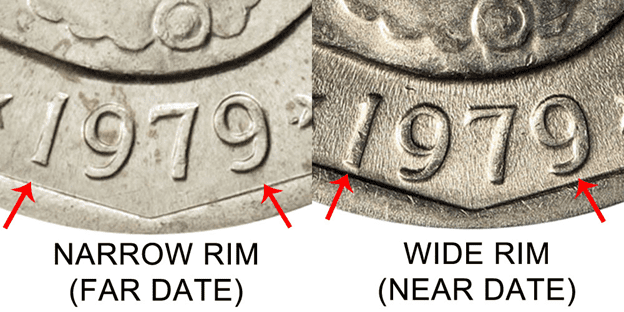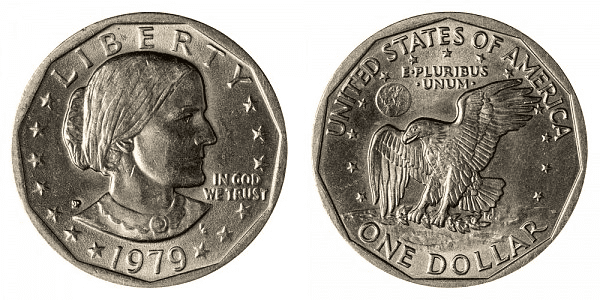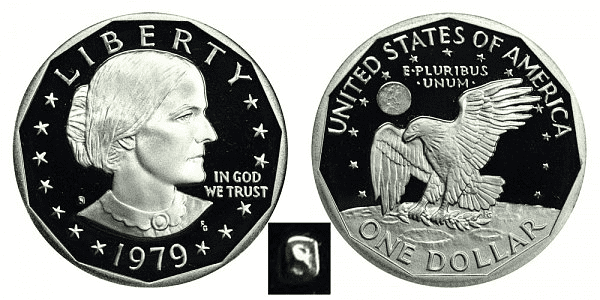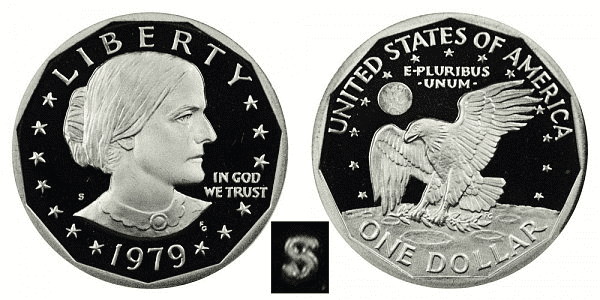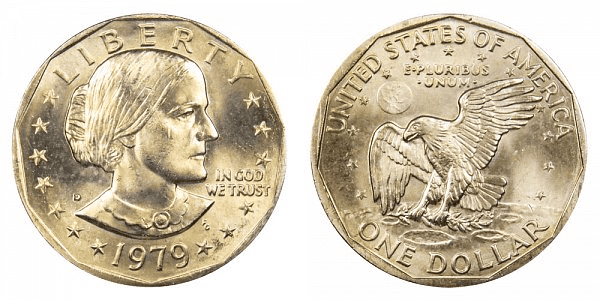What Makes A 1979 Liberty Silver Dollar Valuable?
The Susan B. Anthony dollar was first made available in 1979 by the United States Mint. The coin was comprised of 91.67% Copper and 8.33% Nickel. At the time the mint had high expectations for how successful this new, smaller dollar currency would circulate in the US.
The Treasury Department wanted to do away with one-dollar bills made of paper in order to save production expenses by millions of dollars annually.
This coin pays tribute to a trailblazer in the fight for women’s rights. A key figure in the women’s suffrage movement, Susan B. Anthony (born Susan Anthony; February 15, 1820–March 13, 1906) was an American social reformer and women’s rights advocate.
She gathered anti-slavery petitions when she was 17 years old. She was raised in a Quaker family that was dedicated to social equality. She was appointed the American Anti-Slavery Society’s agent for the state of New York in 1856.
A law authorized the issuance of the Susan B. Anthony dollar coin on October 10, 1978. Frank
Gasparro, the Chief Engraver of the United States Mint, created both the obverse and reverse. On the obverse, close to the lower right corner of the portrait, are his initials. With the release of this coin, a genuine woman’s portrait—as opposed to an allegory of Lady Liberty—appeared on a United States circulated coin for the first time.
This is why the Susan B. Anthony dollar is often called a liberty dollar, because of the prevalence of lady liberty on dollar coins; in fact, an alternative design featuring lady liberty had been created by Gasparro before ultimately settling on the Susan B. Anthony design instead.
The public, however, rejected the new one-dollar coin since it was easily confused with a quarter.
Production ended in 1981 as a result of declining demand. The mint created an additional batch of these $1 coins in 1999 in response to a request from the USPS.
How To Differentiate Silver Dollar Coins?
Despite the fact there is ‘silver’ in the name of this coin, the Susan B. Anthony Dollar doesn’t contain any silver content, and the silver instead refers to the color of the cladding on the coin and is perhaps a nod to pre-1965 when dollars did indeed contain silver.
For those wondering how to differentiate silver coins from non-silver coins the best way to do so is to inspect the edge of the coin as this is where the most wear to the cladding would occur. You can be certain that a coin is made of silver if it has a solid silver stripe.
The coin is clad if a stripe of copper is visible. The coin may be 40% silver if the silver stripe is more muted and contains very small amounts of copper.
However, as mentioned, as all Susan B. Anthony Silver Dollars were minted in a 91.67% Copper and 8.33% Nickel composition, there is little need to perform this check.
1979 Susan B. Anthony Silver Dollar Varieties
1979-P Silver Dollar
Year: 1979
Denomination: One Dollar
Mint Mark: Philadelphia
Mintage: 360,222,000
Composition: 91.67% Copper – 8.33% Nickel
Weight: 8.1 grams
Diameter: 26.5 mm
Edge: Plain

photo source: www.usacoinbook.com
Narrow Rim
The obverse of one significant variation of the 1979 P Susan B. Anthony (SBA) Dollar has a thin rim. The 1979 year is spaced further apart from the 11-sided rim because it is somewhat narrower. Due to the date’s distance from the rim, this variation is occasionally referred to as the “far date.”
The following example comparison image illustrates the differences between the 1979 Susan B. Anthony dollar narrow rim and wide rim (far date and near date) varieties:

photo source: www.usacoinbook.com
Wide Rim

photo source: www.usacoinbook.com
1979-S Silver Dollar
Type 1: Filled S Proof
Year: 1979
Denomination: One Dollar
Mint Mark: San Francisco
Mintage: 3,677,175
Composition: 91.67% Copper – 8.33% Nickel
Weight: 8.1 grams
Diameter: 26.5 mm
Edge: Plain

photo source: www.usacoinbook.com
Type 2: Clear S Proof

photo source: www.usacoinbook.com
The Type 2 Clear S from 1979 The Susan B. Anthony (SBA) Dollar is only available as a proof coin and has a considerably more distinct and legible S mintmark.
1979-D Silver Dollar
Year: 1979
Denomination: One Dollar
Mint Mark: Denver
Mintage: 288,015,744
Composition: 91.67% Copper – 8.33% Nickel
Weight: 8.1 grams
Diameter: 26.5 mm
Edge: Plain

photo source: www.usacoinbook.com
List of errors
Clipped Planchets
Keep hold of any Susan B. Anthony dollar you come across that has what seems to be a straight edge or a crescent-shaped cut on one side. A clipped planchet mistake can be the cause. Dollar errors on Susan B. Anthony clipped planchets are valued at least $25.
Multiple Strikes
A planchet becoming trapped on the press between the dies causes at least one additional, inadvertent striking, which is known as multiple striking. The end result is a coin with many representations of the same design, sometimes facing the same way and other times from other angles. Multiple strikes on a Susan B. Anthony dollar are worth at least $500.
Empty Planchets
How can you distinguish a blank dollar planchet from one for any other coin? Its diameter of 26.5 millimeters and weight of 8.1 grammes on a coin scale make it the only coin in the US constructed of copper-nickel clad. It’s worth at least $100 to correct these Susan B. Anthony dollar blank planchet mistakes.
Off Center Strikes
There weren’t many off-center Susan B. Anthony coins made. Those that were are quite uncommon. Depending on how significantly off centre the strike is, the majority of those that do surface have an off-center strike of at least 5% to 10% and can range in worth from $150 to $500 or more.
Broadstrikes
When a coin is struck but is not kept inside its collar, it makes a broad strike. The coin typically flattens out past its normal dimensions and loses its created rim when this occurs. Broadstrike Susan B. Anthony dollars typically don’t have their reeded edges or crisp rims. These rare errors are priced between $50 and $100 per.
Wrong Planchet
These uncommon mistakes happen when a coin of the same or smaller denomination is accidentally struck with a design from a coin of a wider physical size. The design on the Susan B. Anthony dollar could have been struck on planchets from the Sacagawea dollar, Washington quarter, Roosevelt dime, Jefferson nickel, or Lincoln penny.
When the last Susan B. Anthony dollars were released from the presses in 1999, planchets for the golden dollar, which made its debut in 2000, were already available.
Wrong planchet coins, which are extraordinarily uncommon faults, virtually invariably trade for hundreds or even thousands of dollars. One Sacagawea dollar planchet struck with a 1999-P Susan B. Anthony dollar sold for $16,800 in 2020.
In contrast, a 1979-S Susan B. Anthony dollar struck on a dime planchet sold for $10,062.50 at auction in 2004.
How Much Is A 1979 Susan B. Anthony Dollar Worth Today?
The Susan B. Anthony Dollar has a melt value of around $0.0719082 which is far less than its face value. A circulated 1979-P Wide Rim dollar is about $5 to $8, while uncirculated specimens of the 1979-P dollar are worth for $20 and above.
1979-P and 1979-D dollars are for face value if worn and about $2 and up in uncirculated condition. In ordinary proof grades, a 1979-S Type I dollar is worth between $3 and $5. The value of the 1979-S Type II proof dollar ranges from $25 and above.
As you can see from the error list above the most valuable dollars are those with clear faults as opposed to those in pristine condition.
How Does The Grading System Work?
The Sheldon Scale is used by numismatists to provide a numerical value to coins. The Sheldon Scale goes from poor (P-1) to perfect mint state (P-1) (MS-70). Coins were originally evaluated using words to reflect their condition (Good, Fair, Excellent, Etc.). Unfortunately, coin collectors and dealers had different ideas about what each of these terms represent.
Professional numismatists joined together in the 1970s and established CoinGrading standards. These numismatists now assign grades at key places on the seventy-point scale, using the most regularly utilized numeric points in conjunction with the original adjective grade. The following are the most common coin grades:
-
-
- (P-1) Poor – Indistinguishable and probably damaged; if used, must have a date and mintmark; otherwise, rather battered.
- (FR-2) Fair – Nearly smooth, but without the damage that a coin graded Poor often possesses. The coin must have enough detail to be identified.
- (G-4) Fair – Inscriptions have merged into the rims in some areas, and important elements have been mostly erased.
- (VG-8) Very Good- A little weathered, but all of the primary design elements are visible, albeit faintly. There is little if any, central detail left.
- (F-12) Good – The item is very worn, yet the wear is even, and the overall design details stand out clearly. Rims are almost completely isolated from the field.
- (VF-20) Very Fine – Moderately weathered, with some finer features still visible. The motto or all letters of LIBERTY are readable. Both sides of the coin have entire rims that are separated from the field.
- (EF-40) Extremely Fine – Gently used; all gadgets are visible, and the most important ones are bold. The finer details are bold and clear, however, light wear may be seen.
- (AU-50) Uncirculated – Slight evidence of wear on the coin’s design’s high points; may have contact marks; eye appeal should be adequate.
- (AU-58) Uncirculated Choice – Slight traces of wear, no severe contact marks, almost full mint shine, and great eye appeal.
- (MS-60) Mint State Basal – Strictly uncirculated; no indication of wear on the coin’s highest points, but an unsightly coin with reduced luster, visible contact marks, hairlines, and other flaws.
- (MS-63) Mint State Acceptable – Uncirculated, but with contact scratches and nicks, little reduced shine, but otherwise appealing appearance. The strike is weak to average.
- (MS-65) Mint State Choice – Uncirculated with great mint shine, very little contact blemishes, and exceptional eye appeal. The strike is unusually severe.
- (MS-68) Mint State Premium Quality – Uncirculated with superb luster, no obvious contact marks to the naked eye, and exceptional eye appeal. The strike is quick and appealing.
- (MS-69) Almost Perfect Mint State – Uncirculated with perfect brilliance, a sharp and appealing strike, and extremely good eye appeal. A near-perfect coin with minor imperfections in the planchet, strike, and contact markings (seen only under 8x magnification).
- (MS-70) Mint State Perfect – Under 8x magnification, there are no tiny imperfections discernible; the strike is crisp, and the coin is perfectly centered on a beautiful planchet. Rarely seen on a coin, this coin is bright and whole, with original luster and exceptional eye appeal.
-
Where To Buy Or Sell 1979 Susan B. Anthony Dollar?
Run-of-the-mill Susan B. Anthony dollars can easily be purchased at flea markets, estate sales, and online marketplaces such as eBay.
Before selling your dollar, however, make sure to check that there are no irregularities that could command a higher price, such as errors.
If you’re unsure there are many great coin collecting forums you can check out for help. When buying or selling a rare example of this coin it’s vital you do so through a legitimate auction house or coin specialist to avoid getting scammed.
FAQs
Is there a mint mark on a 1979 Susan B. Anthony dollar?
Yes, all Susan B. Anthony coins will feature a mint mark (P, S, or D). The mint mark is found on the obverse side of the coin to the left of Anthony’s neck.
What affects the value of the silver dollar?
As with all coins, the condition will impact the overall value. The value of a Susan B. Anthony dollar can be greatly increased if any errors are present in the coin.
Is a 1979 dollar real silver?
There is no silver content in the 1979 Susan B. Anthony dollar, instead, it is comprised of 91.67% Copper – 8.33% Nickel.
What is the value of a 1979 Canadian silver dollar?
Because it has a precious metal content the base value of the 1979 silver dollar is far more than the Susan B. Anthony dollar with a melt value of $9.87 CAD.


